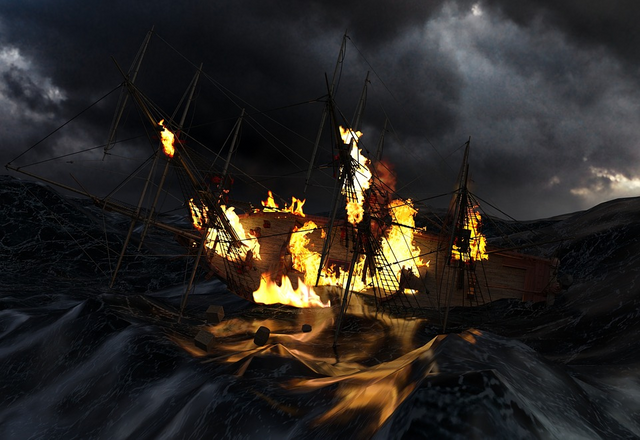The General Slocum Disaster - a random glance at history
On June 15, 1904, a paddle boat steamer, the General Slocum caught fire in New York's East River and was forced to ground itself. As a result of the incident, somewhere around 1,021 people lost their lives. Here's what happened.
Background

pixabay license: source
The other day, I included a link to Stuff You Missed in History Class in my article, History, Music, and Entertainment micro-summaries for June 17, 2019. I thought the story was interesting enough that I'd dedicate some time to it and cover it with some more detail in its own post here, too.
The General Slocum was a paddle boat, also known as a side wheel passenger steamer. Named after a Civil War General, the ship was built in 1891 and operated as a ferry and charter boat in New York's East River. The ship was owned by the Knickerbocker steamboat company and captained by William H. Van Schaick, who was regarded as a safe and careful sailor, but the steam boat had been in a number of accidents, and Van Schaick was 67 years old, so some people were apparently already thinking that he was due for retirement.
The ship had passed an inspection, just over a month earlier on May 5th, but it was showing signs of age, and it was filled with flammable materials like bags of charcoal, rubbish, machine oils, containers of hay, and even the paint that had been applied to the ship recently. It had three decks and was licensed to carry up to 2,500 passengers.
On June 5, 1904, the ship was chartered for a picnic celebrating the end of the school year by St. Mark's Evangelical Lutheran Church in New York's Kleindeutschland. or Little Germany, a German-American community in New York's Lower East Side. Since it was a work day in a working class community, most of the passengers were women and children, as the men of the families were more likely to be at work. It is estimated that 1,358 passengers boarded the ship that day, although the number is not certain because multiple children may have boarded under single tickets.


pixabay license: source
The fire
The families were dressed in celebratory clothing when they boarded the ship, and once it set out into the water, many of the children were allowed to explore the ship freely. They expected a fun-filled day including a 2 hour cruise with a band playing on the promenade deck, and a picnic outside of the city, but anticipation turned to fear soon after the ship launched.
They left the dock between 9:30 and 9:40, and soon afterwards a fire started in a forward compartment on the main deck. A child apparently reported it to one of the crew members, but was told to "mind his own business". The fire had many possible causes, but it's not clear what the actual cause was. Suffice it to say that numerous people had open flames in the room where it started.
As the ship approached a narrow part of the river known as East Hellgate, others noticed the fire and tried to put it out. At first, they failed because the old linen hoses failed. A new rubber hose was available, but the crew wasn't able to connect it to the faucet because they were unaware that the connectors from the old hose were still connected, and the fire buckets on the ship were all empty.


pixabay license: source
Ineffective response
After attempts to extinguish the fire were abandoned, the decision was made to ground the ship. The captain decided that the closest place to ground the ship was unsuitable because it was filled with lumber and other flammable material. As a result, he decided to ground it on North Brothers Island, and this meant that the ship had to go through deep water and against strong headwinds (which fanned the flames).
Many of the passengers could not swim, and they were dressed in their "Sunday best" outfits, which tended to get heavy when wet and made swimming even more difficult, so as the ship plowed through the deep waters and the fire spread, many passengers were faced with a choice between burning to death or jumping into deep water to near-certain drowning. The ship did have life preservers, but the crew did not do an effective job of distributing them, and many of them had deteriorated from age and rot.
Just before reaching shore, a deck collapsed, which dumped hundreds more passengers into the water. Even when the ship made it to the beach, it landed in such a way that the fire was between most of the passengers and the shore, so even more passengers were forced to jump overboard into the water.
In the end, despite rescue attempts by a number of nearby observers, approximately 1,000 people - 70% of the passengers aboard - died in the accident. Only 228 passengers emerged without injury. On the other hand, only 2 of 30 or more crew members were killed, and just a handful of others were injured.
In terms of deaths, it was New York's worst single day disaster until the 9/11 terrorist attacks in 2001.


pixabay license: source
The aftermath
Bodies were still washing ashore on the banks of the East River for a number of days afterwards, and the disaster was devastating to New York's German-American community. 600 families lost at least one family member, and many of those who survived were permanently scarred with physical and emotional injuries. Because the victims were mostly women and children, it caused a dramatic change for the neighborhood's demographics and character. With so many lost children, there were reports that the neighborhood was strangely quiet. The church, itself, lost much of its congregation and was converted into a synagogue in the 1940s.
A number of investigations were held to determine what had happened, and charges were recommended against the ship captain, executives in the Knickerbocker Steam Boat Company, and the government inspectors.
Problems that these investigators uncovered included lack of training for the crew - who lacked basic skills like familiarity with the ship's fire alarm, lack of maintenance, and even problems with the supplier of life vests - the manufacturer was required to include 6 pounds of cork in the vest, but was discovered to be using less and making up the weight difference with bars of iron!
Multiple people were indicted, but Captain Van Schaick was the only one to receive a conviction. He was convicted of criminal negligence and sentenced to 10 years in prison. None of the company's executives or government inspectors were convicted. After lobbying efforts from his wife, Van Schaick was freed from prison and pardoned by President Taft in 1911.


pixabay license: source
Conclusion
It is surprising to me that I've never heard of this disaster before now. In terms of deaths, the Titanic lost 1,500 people, the Hindenberg lost 36, and the Triangle Shirtwaist fire lost 78, so it's curious why those are all widely remembered but the Slocum's 1,021 lost souls seem to be more obscure. (Maybe Hollywood needs to make a movie about it! ; -)
This disaster has been noted, however, to be one of the reasons behind formal life-saving training programs and routine swimming classes for children that have emerged in the modern United States. It also led to a number of reforms in the passenger ship excursion industry of the day.
On a personal note, this story probably caught my attention because my own great-grandparents in one side of the family were all German immigrants in the late 1800s and early 1900s, so I feel a small sense of connection to the impacted community. One of the childhood stories that I heard from my grandmother was about her experience having her eyelids turned inside-out by a customs official as a young girl when passing through New York's Ellis Island on her return trip from a visit to see family in Germany.
It's an interesting historical story, and I definitely recommend that you click through to the podcast to hear more information about the tragedy.

References
- The General Slocum Disaster (podcast)
- History, Music, and Entertainment micro-summaries for June 17, 2019
Thank you for your time and attention.
As a general rule, I up-vote comments that demonstrate "proof of reading".
Steve Palmer is an IT professional with three decades of professional experience in data communications and information systems. He holds a bachelor's degree in mathematics, a master's degree in computer science, and a master's degree in information systems and technology management. He has been awarded 3 US patents.
Steve is also a co-founder of the Steem's Best Classical Music Facebook page, and the @classical-music steemit curation account.
Follow in RSS: @remlaps, @remlaps-lite


Wow what a story and goes to show what havoc general carelessness can wreak! Thanks for sharing this, learn something new every day
It really does. I was especially surprised by the follow-on effect that it had on the community.
Goes to show "everyday" events can be deadly. I don't trust large or even sized populaces anymore.
Supplemental information. I just happened to come across the post Forbidden Photography 📷 by @cognoscere which has photos of North Brother Island, the island where the General Slocum caught fire.